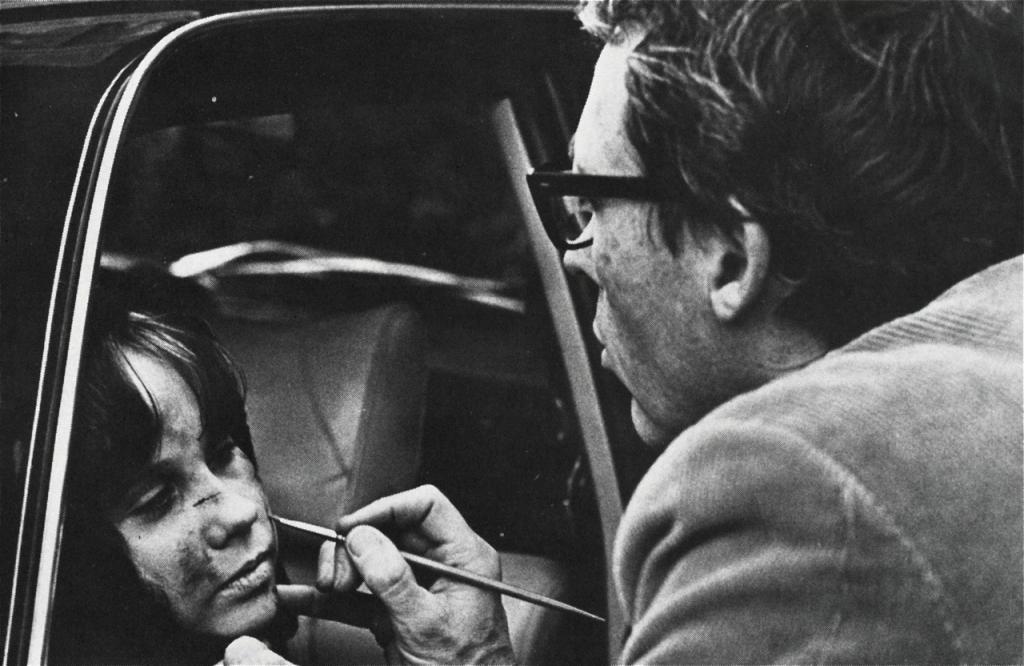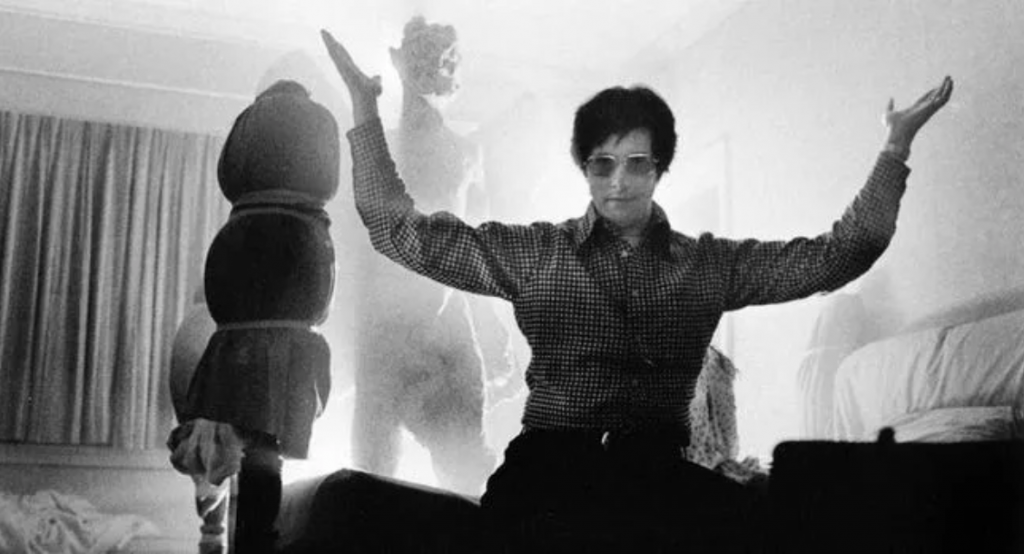When William Peter Blatty (1928 – 2017) the writer of “The Exorcist” and subsequent writer and director of the sequel “The Exorcist III” began to visualize the screenplay for the original movie, he wanted to create a paranormal experience that would surpass anything that anyone had seen in the theaters before.
The book was published in 1971, and it spent fifty-seven weeks on the New York Times bestseller list. It was because of the explosive success of “The Exorcist” book (which sold over 13 million copies in the United States alone after publishing) that the movie was shot in 9 short months, and released in 1973. The movie “The Exorcist” received 10 Academy Award nominations, and won 15 other film awards internationally.
After the movie was released on December 26, 1973, audiences flocked to see it. The imagery in the movie proved to be so shocking for 70’s audiences (who had never seen anything like it on the big screen before) that several individuals filed civil personal injury suits against Warner Bros. From instances of fainting and vomiting in the theater, to heart attacks and miscarriages, the reports of emotional damage after watching the film were so prolific that one psychiatric journal published a research paper discussing the ‘cinematic neurosis’ triggered specifically by the film.
To this day, few films have managed to capture the raw sense of evil that “The Exorcist” did. In fact, both William Peter Blatty (writer/producer) and Director William Friedkin went to great lengths to capture the realism of a true historical exorcism (on which the book was based) that many people suspect something ominous and evil was attracted to the set of the movie.
Check out these 6 paranormal events that happened on the set of “The Exorcist” and you decide whether evil entities may have been ‘hanging out’. Do you think that occult movies attract dark presences and influences?
1. The Original Home for the McNeil Home Was Destroyed by Fire
The interior sets for filming were built in New York City, however the exterior shots (and the McNeil home) was to be filmed on location in Washington, D.C. The entire set for the MacNeil home caught fire and burned to the ground, which delayed filming for six additional weeks. There was one room completely untouched however in the catastrophic blaze; the bedroom of Regan McNeil.
The source of the fire and the strange and eerie fact that the bedroom had remained intact, was enough to make the writer and director seek out a Jesuit Priest (Thomas M. King) to bless the set, however unsettling and unexplainable mishaps continued to occur during the production of the movie.
Nothing says “relax, it’s not dangerous here” better than having a Priest stop by to splash Holy Water over the set. Yikes.
2. Ellen Burstyn (Chris McNeil) Sustains Permanent Spinal Injury
In that famous scene where Regan McNeil is mutilating herself with a Crucifix, actress Ellen Burstyn (Chris McNeil) rushes to the bed to stop her daughter. The demon then shoves Chris McNeil across the room in one violent motion, and her scream is blood curdling and painful.
That chilling scream that many of us will never forget, was actually authentic. The stuntmen had a wire rigged to the actress to pull her backwards and abruptly for the filming of the scene. Unfortunately, the mechanics were rigged with full force, and her painful scream was the result of a permanent and painful spinal injury that she sustained during filming.
Linda Blair (the actress who portrayed Regan McNeil) also sustained a serious back injury, when the set rigging that helped her levitate above her bed broke, sending her crashing to the floor.

3. Abusive Directing Methods Used by William Friedkin
When you watch “The Exorcist” you can literally feel the fear that the actors are portraying in the movie. That is one of the rare qualities of the film that still makes it stand out among horror and paranormal movies and the original and most terrifying film of all time. Directors are often known to use unusual methods to elicit realistic responses from actors, but on the set of “The Exorcist” William Friedkin went over the top to create that realism.
The Director would slap people, scream at them and make them cry, and also fire guns beside their faces to create ‘shock’ or trauma, before filming critical scenes. If every actor in the film seems traumatized it’s because they actually were; and that led actors like Ellen Burstyn to call Friedkin a maniac. And not in a fun, joking way.
People who are traumatized are also more vulnerable to demonic suggestion while they are tired, and emotionally fatigued. Something that was also linked to some of the more bizarre happenings on the set during filming.
4. Inanimate Objects Moved on the Set
The character Father Karras was played by actor Jason Miller, who reported many strange paranormal experiences while he was filming the movie. That Jesuit Priest that was called to bless the set hung around off and on during the filming (because of unexplained events) and Miller reported that the Priest gave him an eerie warning:
“Reveal the devil for the trickster that he is, he will seek retribution against you or he will even try to stop what you are trying to do to unmask him”. And then, Miller was handed an amulet for protection; a medallion of the Blessed Virgin Mary. Later, in character Father Karras’ dream, a medallion falls in slow motion to the ground, incorporated by the Director and Producer after the exchange with the Jesuit Priest.
Several members of the crew witnessed seeing inanimate objects move on the set, before their eyes. Writer and Producer William Blatty reported that the telephone that was used to communicate between the set and the production office would rise off the hook and then crash to the floor.
William Blatty also claimed that he felt a dark presence around him when he was writing the book. He also reported instances where he woke to find himself levitating in his home.

5. Nine Deaths from Crew and Actors Associated with the Film
During the production of “The Exorcist” Jack MacGowren (an Irish actor) portrayed the role of Burke Dennings, Chris McNeil’s manager / possible romantic interest. It was Burke Dennings that connected Chris McNeil to Father Karras, as they both worked at Georgetown University. Burke Dennings is the first victim of possessed child Regan McNeil; his neck is snapped as his head is turned 360° and his body tumbles down the steep flight of stairs after being thrown out the window by a mysterious force.
Actor Jack MacGowren contracted pneumonia on the set. When the movie was shot, the bedroom of character Regan McNeil was refrigerated to freezer proportions. In fact, the crew was required to wear parkas! This helped create the paranormal cold effects and vapor clouds when actors were talking (before CGI). MacGowren died just after his scenes wrapped up, but before the full production was complete. Eight other members of the production and their close family members died during, or shortly after the release of the film.
6. Lightning Strikes Ancient Crucifix in Rome Screening
When “The Exorcist” was released, it was screened in one particular theatre in Rome (near the Vatican). The theater was located between two historic churches. One the day the movie was released in Rome, there were unseasonal torrential rains and a thunderstorm (which added we’re sure to the scary effect for Italian movie goers).
During the storm, a 400-year-old cross was struck by lightning and fell to the ground, in the middle of the piazza (or square) just outside the move theater. How is that for a clear message from the superpowers that be? Maybe they didn’t like the fact that “The Exorcist” was released the day after Christmas; intentionally, to spark international religious furor.
Billy Graham (televangelist) spoke frequently about the film publicly and claimed that ‘the very celluloid of the film itself was cursed’ with powerful subliminal and demonic imagery. He went on to further explain to his followers that he believed a demon lived within the movie reel, captured during the filmmaking process, and that its power could influence anyone who watched the movie.
What do you think? Is it possible for occult films to attract malevolent forces that can do harm? Do films of this genre open a door to the paranormal, and has anything eerie happened to you when you’ve watched “The Exorcist” or another movie about a demonic possession? Share your comments with us.
Generation X gamer girl, marketing professional and closet horror writer. Lover of fast moving horror movies, slow moving zombies and historically based paranormal lore.

